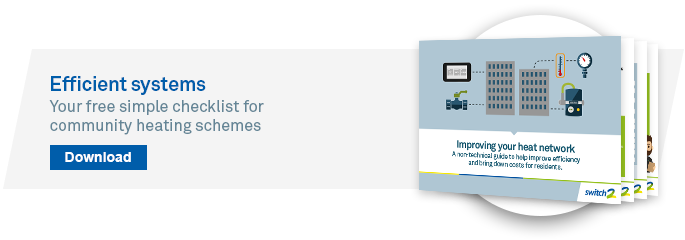A successful metering strategy is crucial to delivering high performing district heating schemes. But connect this with the Building Energy Management System (BEMS) and remote monitoring, and now you're on to something!
Heat metering is essential to the efficiency, compliance, and transparency of any community or district heating project. Unless you have a firm understanding of how, when and where heat is being consumed, it’s impossible to know whether it is being supplied efficiently and effectively, and to pinpoint any waste that might be occurring.
Regulatory requirements
The Heat Network Billing and Metering Regulations make it mandatory to fit final customer meters in new build projects and most buildings undergoing major refurbishment. It is also compulsory for all heat networks to install point of entry meters, which record the amount of heat delivered into the building. The legislation also rules that heat customers must be billed using actual meter readings, rather than estimates, at least one a year, and that billing information must be transparent and informative.
Heat metering benefits
But getting your metering strategy right is not just about compliance and billing, there are big benefits in raising energy efficiency, operational performance, and delivering higher standards of customer service.
Your metering should be of the right type, installed in the right place, and measure the right factors. It should provide reliable and accurate data, which can inform the successful operation of your scheme. A range of stakeholders should be involved in the process – from designers and developers – to end customers.
Data insights
A good metering scheme will monitor and record essential data, such as flow rates and temperatures. This can cut heat losses, reduce overheating and reduce pumping costs, which can have a significant impact on cost, carbon performance and comfort levels.
The data insights can pinpoint energy waste, enabling remedial actions to be taken to optimise system operation, and increasing affordability and sustainability. These insights can also highlight problems with the heat network infrastructure, such as faulty equipment, leading to greater operational efficiency.
A well-designed metering system also provides greater transparency for end customers, demonstrating whether they are being charged fairly for the heat they are consuming. When heat meters link in to advanced smart metering solutions, transparency can be taken to a new level. New technologies, such as Incontro, which include an in-home display, enable residents to see precisely how much energy they are using and how much it is costing, as well as providing a convenient payment and budgeting system.
Improving transparency and customer service is especially important given current Competition and Markets Authority (CMA) proposals to regulate the heat network sector and promote customer protection.
Four steps to successful heat metering
There are four key components to a successful heat metering strategy. These are:
1. Planning your metering strategyThe objective is to present a clear and detailed proposal of the metering that will be installed, and how it will be connected for data collection and management. Key to this is producing a clear and complete schematic, including a detailed meter point schedule, that can be easily understood by all stakeholders. |
2. Sufficient metering and sub-meteringSkimping on heat metering is false economy as this can result in impaired performance and compliance failures. There must be enough heat meters, installed at the meter points, and in the right places, to measure energy supply and consumption by each customer. The further the heat network is broken down into smaller subsystems with their own sub metering, the better the operational control and efficiency of the entire district heating scheme. |
3. Reliable equipmentIt is essential to use quality heat meters from a supplier with MID approvals, and to follow the supplier’s installation instructions. Heat meters must provide complete reliability to ensure that that energy bills are accurate and to ensure continued monitoring of how well a network is running. Effective commissioning of equipment is also paramount. |
4. Effective data collectionReading meters is possibly the biggest challenge. Automatic meter reading (AMR) is the best option and should be fitted with an Mbus communications module, which will facilitate the process and ensure the serial number to the feed is correct. Decide how you will use the information and how often you want to collect the meter readings. A daily service is good for billing purposes, but you may also want to retrieve information on an hourly or half hourly basis to monitor system performance, particularly to analyse the system at high and low demand periods. Heat metering is the intelligent ‘artery’ of district and community heating schemes and must be considered from the outset as part of the project design and planning process. |
Key takeaways
- Heat metering is essential to the efficiency, compliance, and transparency of any community or district heating project
- The Heat Network Billing and Metering Regulations make it mandatory to fit final customer meters in new build projects and most buildings undergoing major refurbishment
- A good metering scheme will monitor and record essential data, such as flow rates and temperatures. Cutting heat losses, reduce overheating and pumping costs
- It can pinpoint energy waste, enabling remedial actions to be taken to optimise system operation, and increasing affordability and sustainability



